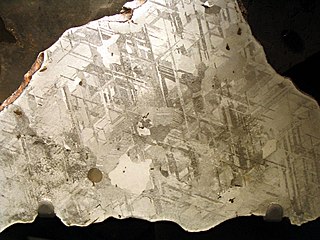
Kamacite is an alloy of iron and nickel, which is found on Earth only in meteorites. The proportion iron:nickel is between 90:10 and 95:5; small quantities of other elements, such as cobalt or carbon may also be present. The mineral has a metallic luster, is gray and has no clear cleavage although its crystal structure is isometric-hexoctahedral. Its density is about 8 g/cm3 and its hardness is 4 on the Mohs scale. It is also sometimes called balkeneisen.
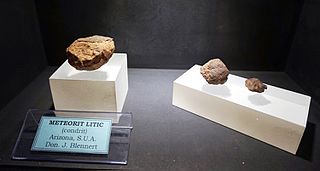
A meteorite classification system attempts to group similar meteorites and allows scientists to communicate with a standardized terminology when discussing them. Meteorites are classified according to a variety of characteristics, especially mineralogical, petrological, chemical, and isotopic properties.

The Murchison meteorite is a meteorite that fell in Australia in 1969 near Murchison, Victoria. It belongs to a group of meteorites rich in organic compounds. Due to its mass and the fact that it was an observed fall, the Murchison meteorite is one of the most studied of all meteorites.

Meteoric iron, sometimes meteoritic iron, is a native metal and early-universe protoplanetary-disk remnant found in meteorites and made from the elements iron and nickel mainly in the form of the mineral phases kamacite and taenite. Meteoric iron makes up the bulk of iron meteorites but is also found in other meteorites. Apart from minor amounts of telluric iron, meteoric iron is the only naturally occurring native metal of the element iron on the Earth's surface.

Hexahedrites are a structural class of iron meteorite. They are composed almost exclusively of the nickel–iron alloy kamacite and are lower in nickel content than the octahedrites. The nickel concentration in hexahedrites is always below 5.8% and only rarely below 5.3%.
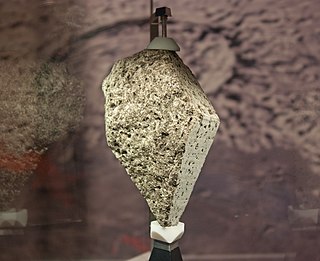
Moon rock or lunar rock refers to rock that is found on the Earth's Moon. This includes lunar material collected during the course of human exploration of the Moon, and rock that has been ejected naturally from the Moon's surface and landed on the Earth as meteorites.

Neumann lines, or Neumann bands, are fine patterns of parallel lines seen in cross-sections of many hexahedrite iron meteorites in the kamacite phase, although they may appear also in octahedrites provided the kamacite phase is about 30 micrometres wide. They can be seen after a polished meteorite cross-section is treated with acid. The lines are indicative of a shock-induced deformation of the kamacite crystal, and are thought to be due to impact events on the parent body of the meteorite.

Iron meteorites, also known as siderites, or ferrous meteorites, are a type of meteorites that consist overwhelmingly of an iron–nickel alloy known as meteoric iron that usually consists of two mineral phases: kamacite and taenite. Iron meteorites originate from cores of planetesimals.
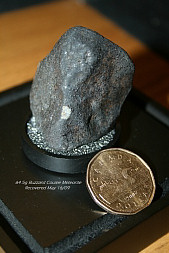
Buzzard Coulee is the collective name of the meteorites fallen on November 20, 2008 over Saskatchewan, Canada.

The Weston meteorite is an H4 ordinary chondrite meteorite which fell to earth above the town of Weston, Connecticut on the morning of December 14, 1807.
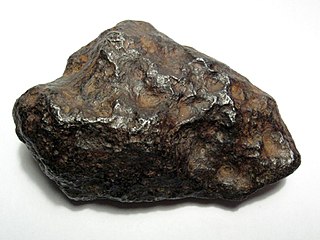
The Chinga meteorite is an iron meteorite. It is structurally an ataxite with very rare kamacite lamella. The meteoric iron is a part of the lamella taenite. The total chemical composition is 82.8% iron, 16.6% nickel, and the rest mostly cobalt and phosphorus.

IAB meteorites are a group of iron meteorites according to their overall composition and a group of primitive achondrites because of silicate inclusions that show a strong affinity to winonaites and chondrites.

Daubréelite is a rare sulfide mineral. It crystallizes with cubic symmetry and has chemical composition of Fe2+Cr3+2S4. It usually occurs as black platy aggregates.
IIG meteorites are a group of iron meteorites. The group currently has six members. They are hexahedrites with large amounts of schreibersite. The meteoric iron is composed of kamacite.
The Bellsbank meteorite is a hexahedrite iron meteorite with abundant schreibersite. It is classified as a member of the IIG group. It was found in Bellsbank, South Africa in 1955.

The Cranbourne meteorite is an octahedrite iron meteorite. It is the second largest meteorite found in Australia after the Mundrabilla meteorite, but at the time of discovery it was the largest known iron meteorite in the world. It is classified as a main group IAB meteorite.
This is a glossary of terms used in meteoritics, the science of meteorites.

IIAB meteorites are a group of iron meteorites. Their structural classification ranges from hexahedrites to octahedrites. IIABs have the lowest concentration of nickel of all iron meteorite groups. All iron meteorites are derived from the metallic planetary cores of their respective parent bodies, but in the case of the IIABs the metallic magma separated to form not only this meteorite group but also the IIG group.
The Polonnaruwa meteorite is an alleged meteorite that fell on 29 December 2012 close to the city of Polonnaruwa in Sri Lanka, and recovered soon after by Chandra Wickramasinghe's team.
The Lake Murray Meteorite, the largest of its kind ever found in Oklahoma and now ranked as the fifth largest in the world, was discovered on a farm in Carter County, Oklahoma in 1933. At that time it was considered the largest known specimen in the world. The farm was sold to the state of Oklahoma about the same time for the creation of Lake Murray State Park, for which the specimen was named. The largest piece is on display at the park.














